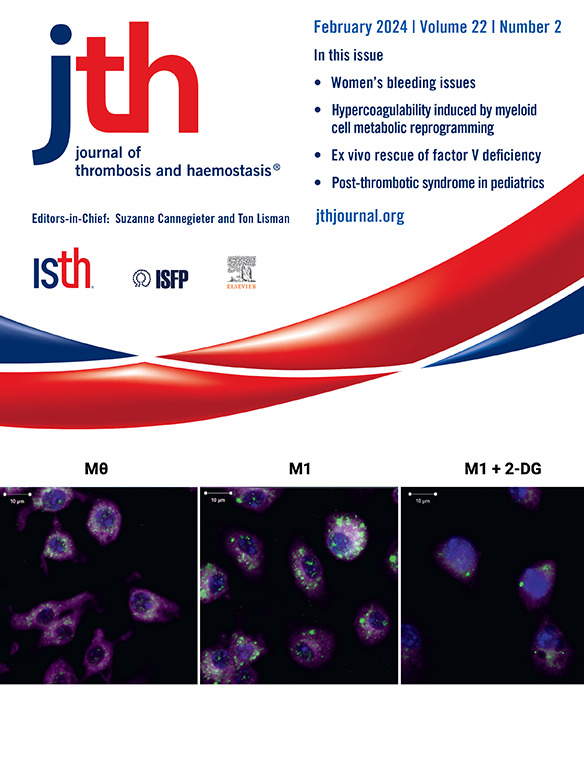Molecular basis of platelet granule defects
IF 5.5
2区 医学
Q1 HEMATOLOGY
引用次数: 0
Abstract
Platelets are small, discoid, anucleate blood cells that play key roles in clotting and other functions involved in health and disease. Platelets are derived from bone marrow-resident megakaryocytes, which undergo a complex developmental process where they increase dramatically in size and produce an abundance of organelles destined for platelets. These organelles include mitochondria, lysosomes, peroxisomes, and 2 unique types of secretory organelles: α- and dense (δ-) granules. δ-Granules contain small molecules, including adenosine triphosphate, adenosine diphosphate, serotonin, and ions, such as calcium and zinc (Ca2+ and Zn2+). α-Granules contain a variety of cargo proteins, which, when secreted by activated platelets, are involved in processes such as hemostasis (eg, fibrinogen and von Willebrand factor), angiogenesis, inflammation, and wound healing. Investigations of patients with inherited conditions resulting in decreased/abnormal platelet secretory granules have led to the identification of proteins, protein complexes, and cellular processes involved in their production by megakaryocytes. Notably, studies of ARPC1B deficiency, Hermansky–Pudlak, and Chediak–Higashi syndromes have linked several genes/proteins to δ-granule biogenesis. Studies of multisystemic arthrogryposis, renal dysfunction, and cholestasis syndrome revealed the requirement of 2 proteins, VPS33B and VPS16B, in α-granule formation. Identification of the genetic cause of gray platelet syndrome established that NBEAL2 is an additional protein needed for α-granule cargo retention. These discoveries enabled studies using animal models, cell culture, and molecular analysis to gain insights into the roles of proteins and cellular processes involved in platelet secretory granule production, which are discussed in this review.
血小板颗粒缺陷的分子基础。
血小板是一种小的、盘状的无核血细胞,在凝血和其他与健康和疾病有关的功能中起着关键作用。血小板来源于骨髓巨核细胞,巨核细胞经历了一个复杂的发育过程,在这个过程中,它们的大小急剧增加,并产生大量用于血小板的细胞器。这些细胞器包括线粒体、溶酶体、过氧化物酶体和两种独特类型的分泌细胞器:α和致密(δ)颗粒。致密的颗粒含有小分子,包括ATP、ADP和血清素,以及离子,如Ca2+和Zn2+。α-颗粒含有多种载货蛋白,这些蛋白由活化的血小板分泌,参与止血(如纤维蛋白原和血管性血友病因子)、血管生成、炎症和伤口愈合等过程。对导致血小板分泌颗粒减少/异常的遗传性疾病患者的研究导致了巨核细胞产生的蛋白质、蛋白质复合物和细胞过程的鉴定。值得注意的是,ARPC1B缺乏症、Hermansky-Pudlak和Chediak-Higashi综合征的研究已经将几个基因/蛋白质与致密颗粒生物发生联系起来。多系统ARC综合征的研究表明,α-颗粒形成需要VPS33B和VPS16B两种蛋白。灰色血小板综合征的遗传原因鉴定表明,NBEAL2是α-颗粒货物保留所需的额外蛋白质。这些发现使得利用动物模型、细胞培养和分子分析的研究能够深入了解血小板分泌颗粒产生过程中蛋白质和细胞过程的作用,本文将对此进行讨论。
本文章由计算机程序翻译,如有差异,请以英文原文为准。
求助全文
约1分钟内获得全文
求助全文
来源期刊
CiteScore
24.30
自引率
3.80%
发文量
321
审稿时长
1 months
期刊介绍:
The Journal of Thrombosis and Haemostasis (JTH) serves as the official journal of the International Society on Thrombosis and Haemostasis. It is dedicated to advancing science related to thrombosis, bleeding disorders, and vascular biology through the dissemination and exchange of information and ideas within the global research community.
Types of Publications:
The journal publishes a variety of content, including:
Original research reports
State-of-the-art reviews
Brief reports
Case reports
Invited commentaries on publications in the Journal
Forum articles
Correspondence
Announcements
Scope of Contributions:
Editors invite contributions from both fundamental and clinical domains. These include:
Basic manuscripts on blood coagulation and fibrinolysis
Studies on proteins and reactions related to thrombosis and haemostasis
Research on blood platelets and their interactions with other biological systems, such as the vessel wall, blood cells, and invading organisms
Clinical manuscripts covering various topics including venous thrombosis, arterial disease, hemophilia, bleeding disorders, and platelet diseases
Clinical manuscripts may encompass etiology, diagnostics, prognosis, prevention, and treatment strategies.

 求助内容:
求助内容: 应助结果提醒方式:
应助结果提醒方式:


